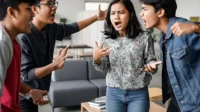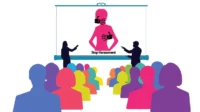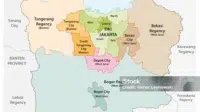Sexual violence is a demeaning act associated with humiliation, degradation, or physical attacks on the victim’s body or reproductive functions. This can result in both psychological and physical suffering (Farikhah, 2023).
It is not uncommon for such cases to be found within the campus environment and committed by members of the academic community itself. Sympathy and empathy within society in response to sexual violence are still very lacking; typically, victims are mistreated or even blamed by society itself.
In recent years up until now, the issue of sexual violence continues to be a roaring topic. According to the catatan tahunan (CATAHU) 2022 released by the National Commission on Violence Against Women (Komnas Perempuan, 2022), the number of gender-based violence cases in 2021 reached the highest level in the past 10 years, with a total of 338,4496 cases.
Sexual violence occurring in higher education institutions has reached an emergency level, as indicated by a survey conducted by the Ministry of Education and Culture in 2020 (Ajie & Romanti, 2021).
The growth in cases of sexual violence has generated worries in society, particularly in the contemporary digital era, which provides opportunity for people to address this issue through working for social change, such as feminist activism.
Feminist movements have occurred, as have numerous movements by women to end domestic and international sexual assault (Mohammed, 1991), Jung, 2003, Keplinger et al, 2019, Jamila, 2021, Saputri & Satiti, 2020).
This article examines the role of women’s social movements in overcoming sexual violence, both through real life and digital social movements.
Sexual violence cases against women have gained worldwide attention due to the significant number of victims, which continues to increase each year. These incidents occur not only in public locations, but also in seemingly safe environments such as college campuses, friends’ homes, and even within someone’s own home.
Sexual violance not only creates physical scars, but also emotional damage for victims, forcing them to remain silent about their sexual violence experience.
Furthermore, this issue is linked to Indonesia’s strong patriarchal culture (unequal power dynamics between men and women), which sometimes interprets women’s clothing as a factor in sexual assault, leading to victim-blaming and excuses for sexual violence (Andris & Edwin, 2023).
In addition, negative societal responses that blame the victims are one of the reasons why many cases go unreported, as victims fear being blamed and humiliated by others around them, despite the fact that sexual violence can harm women who wear fully covered attire themselves.
Women activists can benefit from social media in reaching female audiences beyond their regions and even outside their countries to provide support and education to victims and the public, fostering a more open mindset regarding sexual violence.
Education may start at a young age to prevent future immoral behaviors, and all of this can be initiated through social media. Most sexual assault perpetrators engage in such behavior owing to a lack of education, as they may be ignorant of the boundaries of appropriate behaviour.
Because there are no severe laws in place to condemn offenders, many of them continue committing these horrible acts.
Nowadays, more and more women are bravely shouting out about the painful experiences they have experienced regarding sexual violence. Social media platforms such as Instagram, TikTok, Twitter, and others play an important role in empowering victims to speak up.
Many women prefer to utilize social media because it allows for faster communication with the public, and victims of sexual abuse feel supported and given a platform to address their concerns about social violence issues. Other women help by creating feminist accounts, starting hashtags, and participating in various activities on social media.
Social media has an immense ability to reach, educate, and generate opinions, with the potential to influence attitudes toward violence against women. Therefore, when it comes to getting information or news about incidences of sexual violence, the media significantly influences the level of awareness among its viewers.
Countries can maximize their efforts in terms of education through campaigns and, with the assistance of the legal system, make it easier for victims to promptly report incidents of sexual violence they have experienced.The government can address problems quickly and impose appropriate punishments.
It can be seen that there is still a big gap in both Indonesia’s education and law, requiring victims to wait for an extended period for the results of their complaints to government agencies.
Social media campaigns are not only aimed at women, but also at males, who may be the most common perpetrators of sexual violence against women, as a way to make them more open-minded and conscious of boundaries while engaging with women.
This education is necessary not only for victims, but also for perpetrators, in an effort to prevent similar situations in the future.
Sexual violence education should ideally begin throughout adolescence. Education can also be offered through establishing literacy in efforts to prevent sexual harassment as well as in how to respond to an encounter with sexual harassment.
Similarly, preventing sexual violence will be more effective when everyone stands together to overcome it. One approach to accomplish this is to cultivate in people a sense of humanity. What is more important, though, is the knowledge of the need to humanize a person.
This article, titled “The Role of Women’s Social Movements in Combating Sexual Violence” suggests that sexual violence prevention can be achieved through the collective efforts of social movements operating within both local communities and online platforms.
These movements serve to empower women, enabling them to assert their rights and advocate against instances of abuse.
Moreover, it emphasizes the importance of comprehensive education about sexual violence for individuals of all genders and ages, highlighting the need for widespread awareness and understanding to combat this pervasive issue effectively.
Penulis: Donna Zahrah Luthfiyah
Mahasiswa Ilmu Komunikasi Universitas Padjadjaran
Editor: Ika Ayuni Lestari
Bahasa: Rahmat Al Kafi
Ikuti berita terbaru di Google News
References
Ajie, M. T., & Romanti. (2019, March 9). Inspektorat Jenderal Kemendikbudristek. Retrieved from Mendikbudristek: Ada Darurat Kekerasan Seksual di Lingkungan Perguruan Tinggi!: https://itjen.kemdikbud.go.id/web/mendikbudristek-ada-darurat-%20kekerasan-seksual-di-lingkungan-perguruan-tinggi/#
Farikhah, A. (2023). Pencegahan Kekerasan Seksual.
https://www.djkn.kemenkeu.go.id/artikel/baca/16039/Pencegahan- Kekerasan-Seksual.html
Komisi Nasional Perempuan. (2022, March 7). Kabar Perempuan. Retrieved from PELUNCURAN CATAHU KOMNAS PEREMPUAN 2022 https://komnasperempuan.go.id/kabar-perempuan-detail/peluncuran-catahu-komnas-perempuan-2022















